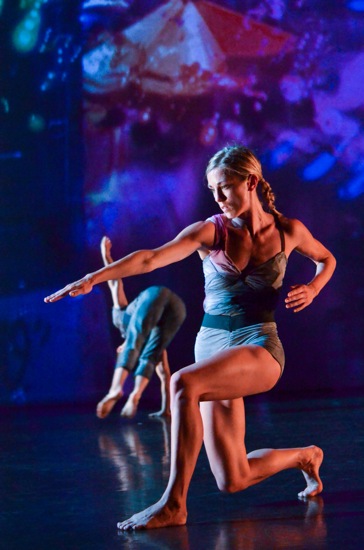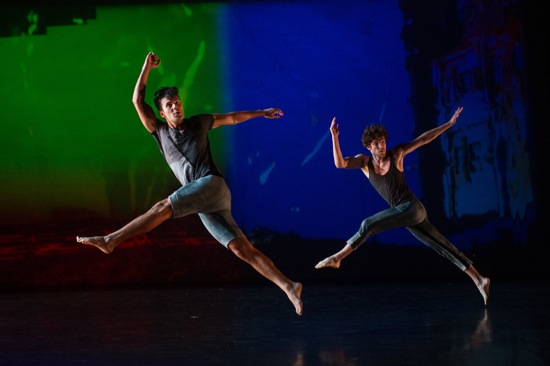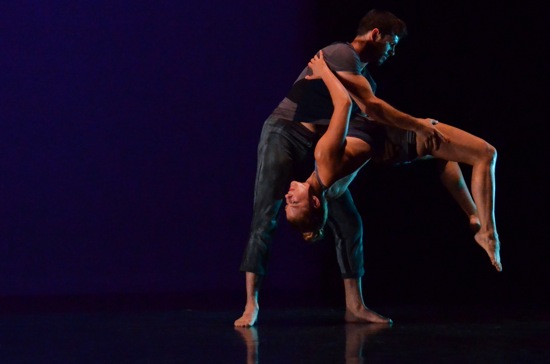
Adele Nickel in Liz Gerring’s she dreams in code. Photo: Taylor Crichton, courtesy of Jacob’s Pillow Dance
The six dancers in Liz Gerring’s she dreams in code move as if tracking along known paths—or maybe it’s the animals being tracked that they resemble in their supple physicality and intent focus. Premiering last fall at the Baryshnikov Center and shown in Jacob’s Pillow’s Doris Duke Studio Theater August 15 through 19, Gerring’s wonderfully poetic work creates an ambiance through stage design, sound score, dimly heard words, and choreography; together, they make you think of dreamscapes. Movement patterns recur in fragments, canonic strands merge into unison and split again. People come and go, pass through, or stay to fit themselves into ongoing phrases of dancing. Often someone’s dancing alone in a corner while others are attracting attention downstage. Images skitter or flow into your consciousness. Familiar sounds in Michael J. Schumacher’s richly imaginative score (a cello, a piano. . .) cede to—or drown in— heavy exhalations or rumbles of a train; delicate tickings or janglings or rattlings overlay pattering drums. (Unlike many of the electronic scores I hear at dance performances, I can see myself sitting down, eyes closed, and listening to this one.)
Canadian media artist Willy Le Maitre’s scenic design also incites dreams. The initial projection on the backdrop, a textured blue-green wash shading to pale red, is also the last one, but the next-to-last images reveal what has been blurred out: a blue wooden building and a smaller red one with a blue-framed window. In one of the projections, a bush has covered the window. Over the course of the piece, many curious visions invade the backdrop: speckled patterns, twinkling points of light, what could be skeletal eye sockets or hole-pocked beach rocks, water dripping down a windowpane, globular shapes descending. . . .A building melts, slides. Strangely unreal snow blankets a city street. There’s a cave, and a sudden huge, blazing star that, along with the music, signals a climax that never quite happens.

Tony Neidenbach (l.) and Ben Asriel in she dreams in code. Photo: Christopher Duggan, courtesy of Jacob’s Pillow Dance.
And then there is the voice of Elizabeth Dement. Midway through she dreams in code, we start to hear it intermittently—sometimes doubled, sometimes swallowed by the music. A woman is softly recounting her dreams. You know the kind. They begin, “Once I saw. . .” or “I was walking down a road. . .” or “I never remember being cold in my dream. . . .”
Gerring challenges us from the start. Part of the sound score is playing softly as the audience enters. Just after the house lights go out, they come back on again with full intensity, accompanying the very evocative lighting created by Carolyn Wong. They’re immediately extinguished again, leaving us wondering whether the flash was a mistake, the music heard earlier a test.
The first four dancers on stage—Ben Asriel, Tony Neidenbach, Brandin Steffensen, and Jessica Weiss—establish the tone. These are athletes: strong, flexible, apparently tireless. Jillian Lewis has dressed them in trim outfits patched in shades of gray and blue; the women’s legs are bare. The performers often hurl themselves into moves, but the ending of each is precise and shaped, however loosely. So are their paths in space. They cover ground with big strides; little fast steps, like a backward jog, are less frequent. Throughout she dreams in code, the dancers are springy—leap and jump easily, cartwheel. But they’re strongly attracted to the ground. How often they lope, bent over; squat; roll; fall; stay fallen a while; tilt off balance; cartwheel. . . .Their hands are on the floor as often as their feet are.

Brandin Steffensen and Jessica Weiss in she dreams in code. Photo: Taylor Crichton, courtesy of Jacob’s Pillow Dance
Two more dancers—Adele Nickel and Claire Westby—enter at the back to instigate counterpoint. There’s no story here, but, of course, given that these are human beings, we attribute motives and emotions and atmospheres to what we see. When the three women, spaced out over the stage, slowly lift one leg behind them and tip forward, they might be leaning over to stare into a pond. They suspend this moment for quite a while. (Some might call this an arabesque penchée; not me. Only the underlying mechanics are the same.) When Steffensen travels on all fours with Weiss hanging under him, her arms clasped around him, you think of the jungle. Partners face each other; one, braced, provides support for some maneuvers, then backs off, so the other can try the whole thing again. As if this were a practice session. At one point, Steffensen, supine, lifts Weiss above him in the woman-flying position we’ve seen in other dances, but this time, the man slowly bends his arms and lowers the woman until she’s lying draped across his body, and they just stay there, breathing together for a few seconds.
I may not have conveyed how much subtle variety Gerring has provided in terms of dynamics and spatial design. Or how skillfully she uses repetition to alter your vision or shift your perception of time from, say, several people, each engaged in a separate fast pursuit, followed by one person doing the same thing over and over. Gerring’s sense of form holds the vigorous, even break-neck actions in control and reveals the dancers as the splendid athletes that they are in a human-scale terrain that’s as challenging as any balance beam.

Lovely evocative writing Deborah, many thanks.
Thank you for this description. I could not attend this and so wish I had been there!